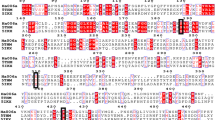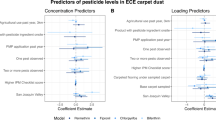Abstract
Two deterministic models (US EPA's Office of Pesticide Programs Residential Standard Operating Procedures (OPP Residential SOPs) and Draft Protocol for Measuring Children's Non-Occupational Exposure to Pesticides by all Relevant Pathways (Draft Protocol)) and four probabilistic models (CARES®, Calendex™, ConsExpo, and SHEDS) were used to estimate aggregate residential exposures to pesticides. The route-specific exposure estimates for young children (2–5 years) generated by each model were compared to evaluate data inputs, algorithms, and underlying assumptions. Three indoor exposure scenarios were considered: crack and crevice, fogger, and flying insect killer. Dermal exposure estimates from the OPP Residential SOPs and the Draft Protocol were 4.75 and 2.37 mg/kg/day (crack and crevice scenario) and 0.73 and 0.36 mg/kg/day (fogger), respectively. The dermal exposure estimates (99th percentile) for the crack and crevice scenario were 16.52, 12.82, 3.57, and 3.30 mg/kg/day for CARES, Calendex, SHEDS, and ConsExpo, respectively. Dermal exposure estimates for the fogger scenario from CARES and Calendex (1.50 and 1.47 mg/kg/day, respectively) were slightly higher than those from SHEDS and ConsExpo (0.74 and 0.55 mg/kg/day, respectively). The ConsExpo derived non-dietary ingestion estimates (99th percentile) under these two scenarios were higher than those from SHEDS, CARES, and Calendex. All models produced extremely low exposure estimates for the flying insect killer scenario. Using similar data inputs, the model estimates by route for these scenarios were consistent and comparable. Most of the models predicted exposures within a factor of 5 at the 50th and 99th percentiles. The differences identified are explained by activity assumptions, input distributions, and exposure algorithms.
This is a preview of subscription content, access via your institution
Access options
Subscribe to this journal
Receive 6 print issues and online access
$259.00 per year
only $43.17 per issue
Buy this article
- Purchase on SpringerLink
- Instant access to full article PDF
Prices may be subject to local taxes which are calculated during checkout








Similar content being viewed by others
References
NAS. 2007. Models in Environmental Regulatory Decision Making. Report of the Committee on Models in the Regulatory Decision Process, National Research Council. ISBN-10: 0-309-11000-9.
US EPA. General Principles for Performing Aggregate Exposure and Risk Assessments. Office of Pesticide Programs, Washington, DC, 2001a.
US EPA. Standard Operating Procedures (SOPs) for Residential Exposure Assessments. Office of Prevention, Pesticides, and Toxic Substances, US Environmental Protection Agency, Washington, DC, 1997. http://www.epa.gov/scipoly/sap/meetings/1997/september/sopindex.htm.
US EPA. Guidelines for Exposure Assessment. Risk Assessment Forum, US Environmental Protection Agency, Washington, DC, 1992. EPA/600/Z-92/001, http://cfpub.epa.gov/ncea/cfm/recordisplay.cfm?deid=15263.
US EPA. Draft Protocol for Measuring Children's Non-Occupational Exposure to Pesticides by All Relevant Pathways. Office of Research and Development, Research Triangle Park, NC, 2001b. EPA/600/R-03/026, http://nepis.epa.gov/.
Williams P.R.D., Hubbell B.J., Weber E., Fehrenbacher C., Hrdy D., and Zartarian V. 2010. An overview of exposure assessment models used by the US Environmental Protection Agency. In: Hanrahan G. (Ed.). Modelling of Pollutants in Complex Environmental Systems, Vol. 2, Chapter 3. UK: ILM Publications, http://www.epa.gov/crem/pdfs/chapter-03.pdf.
FIFRA SAP. 2004a. A Model Comparison: Dietary and Aggregate Exposure in Calendex, CARES, and Lifeline. SAP minutes no. 2004-04, http://www.epa.gov/scipoly/sap/meetings/2004/042904_mtg.htm.
Jacobs L., Driver J., and Pandian M. Residential exposure joint venture: national pesticide use survey – design, implementation, analysis methods, and results, 2003. Report ID: 03-REJV-002. NFO Worldgroup.
Tulve N.S., Egeghy P.P., Fortmann R.C., Xue J., Evans J., Whitaker D.A., and Croghan C.W. Methodologies for estimating cumulative human exposures to current-use pyrethroid pesticides. J Expo Sci Environ Epidemiol 2011: 21: 317–327.
CARES. Cumulative and Aggregate Risk Evaluation System Model. http://www.ilsi.org/ResearchFoundation/Pages/CARES.aspx.
FIFRA SAP. 2002, 2004b. Cumulative and Aggregate Risk Evaluation System (CARES) Model Review, http://www.epa.gov/scipoly/sap/tools/atozindex/cares.htm.
Farrier D.S. CARES (Cumulative and Aggregate Risk Evaluation System). Technical Manual. Washington, DC: Crop Life America, 2002: http://www.ilsi.org/ResearchFoundation/Documents/CARES/CARESTechManualChapters.pdf.
Ross J., Thongsinthusak T., Fong H.R., Margetich S., and Krieger R. Measuring potential dermal transfer of surface pesticide residue generated from indoor fogger use: an interim report. Chemosphere 1990: 20 (3–4): 349–360.
Ross J.H., Fong H.R., Thongsinthusak T., Margetich S., and Krieger R. Measuring potential dermal transfer of surface pesticide residue generated from indoor fogger use: using the CDFA roller method. Interim report II. Chemosphere 1991: 22 (9–10): 975–984.
Delmaar J.E., Park M.V.D.Z., and van Engelen J.G.M. 2005. ConsExpo – consumer exposure and uptake models. RIVM report no. 320104004, http://www.consexpo.com.
SHEDS. Stochastic Human Exposure and Dose Simulation Model. http://www.epa.gov/heasd/products/sheds_multimedia/sheds_mm.html.
Zartarian V.G., Xue J., Glen G., Smith L., Tulve N., and Tornero-Velez R. Quantifying children's aggregate (dietary and residential) exposure and dose to permethrin: application and evaluation of EPA's probabilistic SHEDS-Multimedia model. J Expos Sci Environ Epidemiol 2012: 22 (3): 267–273.
California EPA. Assessment of Children's Exposure to Surface Methamphetamine Residues in Former Clandestine Methamphetamine Labs, and Identification of a Risk-Based Cleanup Standard for Surface Methamphetamine Contamination. External Review Draft. Office of Environmental Health Hazard Assessment. Integrated Risk Assessment Branch, 2007.
Hore P., Zartarian V., Xue J., Ozkaynak H., Wang S.W., Yang Y.C., Chu P.L., Sheldon L., Robson M., Needham L., Barr D., Freeman N., Georgopoulos P., and Lioy P.J. Children's residential exposure to chlorpyrifos: application of CPPAES field measurements of chlorpyrifos and TCPy within MENTOR/SHEDS-Pesticides model. Sci Total Environ 2006: 366 (2–3): 525–537.
Stout II D.M., and Mason M.A. The distribution of chlorpyrifos following a crack and crevice type application in the US EPA indoor air quality research house. Atmos Environ 2003: 37: 5539–5549.
FIFRA SAP. 2007. A Set of Scientific Issues Being Considered by the Environmental Protection Agency Regarding: Review of EPA/ORD/NERL's SHEDS-Multimedia Model Aggregate version 3, SAP Minutes No. 2007–06. August 14–15, 2007 FIFRA Scientific Advisory Panel Meeting, Arlington, VA.
FIFRA SAP. 2010. A Set of Scientific Issues Being Considered by the Environmental Protection Agency Regarding: SHEDS-Multimedia version 4, Peer Consult on PBPK Modeling, and a SHEDS-PBPK Permethrin Study, SAP Minutes No. 2010–06. July 20–22, 2010 FIFRA Scientific Advisory Panel Meeting, Arlington, VA. http://www.epa.gov/scipoly/sap/meetings/2010/july/072010minutes.pdf, http://www.regulations.gov/!docketDetail;D=EPA-HQ-OPP-2010-0383.
Zartarian V.G., Glen G., Smith L., and Xue J. 2008. SHEDS-Multimedia Model Version 3 Technical Manual. US Environmental Protection Agency, Washington, DC, EPA/600/R-08/118, http://www.epa.gov/heasd/products/sheds_multimedia/sheds_mm.html.
McCurdy T., Glen G., Smith L., and Lakkadi Y. The national exposure research laboratory's consolidated human activity database. J Expos Anal Environ Epidemiol 2000: 10: 566–578.
Glen G., Smith L., Isaacs K., McCurdy T., and Langstaff J. A new method of longitudinal diary assembly for human exposure modeling. J Expo Sci Environ Epidemiol 2008: 18 (3): 299–311.
US EPA. Draft Technical Guidelines – Standard Operating Procedures for Residential Pesticide Exposure Assessment submitted to the FIFRA Scientific Advisory Panel for Review and Comment, September 2009. Office of Pesticide Programs, Office of Prevention, Pesticides, and Toxic Substances, Washington, DC, 2009.
Keenan J.J., Ross J.H., Sell V., Vega H.M., and Krieger R.I. Deposition and spatial distribution of insecticides following fogger, perimeter sprays, spot sprays, and crack-and-crevice applications for treatment and control of indoor pests. Reg Toxicol Pharmacol 2010: 58 (2): 189–195.
Stout II. D.M., Bradham K.D., Egeghy P.P., Jones P.A., Croghan C.W., Ashley P.A., Pinzer E., Friedman W., Brinkman M.C., Nishioka M.G., and Cox D.C. American Healthy Homes Survey: a national study of residential pesticides measured from floor wipes. Environ Sci Technol 2009: 43 (12): 4294–4300.
Tulve N.S., Jones P.A., Nishioka M.G., Fortmann R.C., Croghan C.W., Zhou J.Y., Fraser A., Cave C., and Friedman W. Pesticide measurements from the First National Environmental Health Survey of child care centers using a multi-residue GC/MS analysis method. Environ Sci Technol 2006: 40 (20): 6269–6274.
CSFII. Continuing Survey of Food Intakes by Individuals. http://www.ars.usda.gov/Services/docs.htm?docid=14392.
Acknowledgements
The US Environmental Protection Agency through its Office of Research and Development partially funded and managed the research described here. It has been subjected to Agency administrative review and approved for publication.
Author information
Authors and Affiliations
Corresponding author
Ethics declarations
Competing interests
The authors declare no conflict of interest.
Rights and permissions
About this article
Cite this article
Young, B., Tulve, N., Egeghy, P. et al. Comparison of four probabilistic models (CARES®, Calendex™, ConsExpo, and SHEDS) to estimate aggregate residential exposures to pesticides. J Expo Sci Environ Epidemiol 22, 522–532 (2012). https://doi.org/10.1038/jes.2012.54
Received:
Accepted:
Published:
Issue date:
DOI: https://doi.org/10.1038/jes.2012.54



